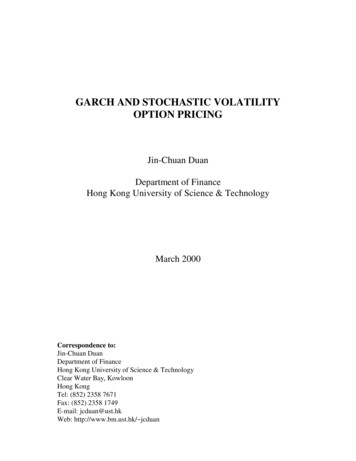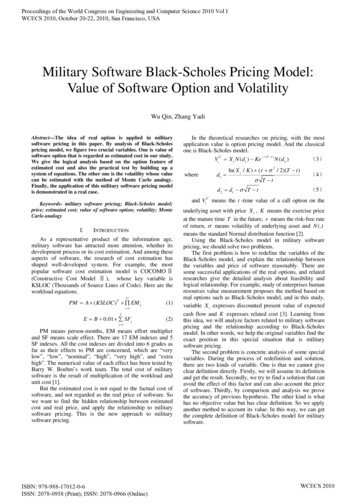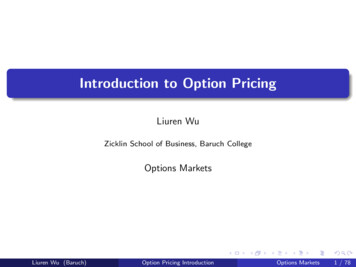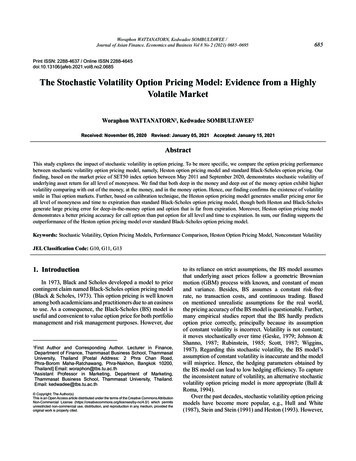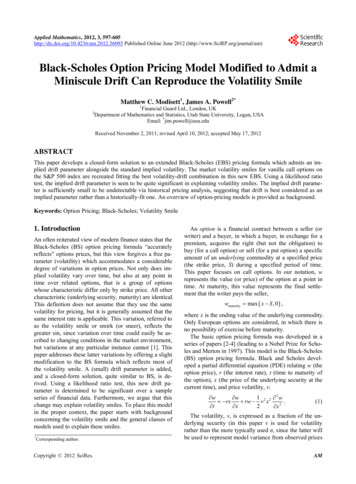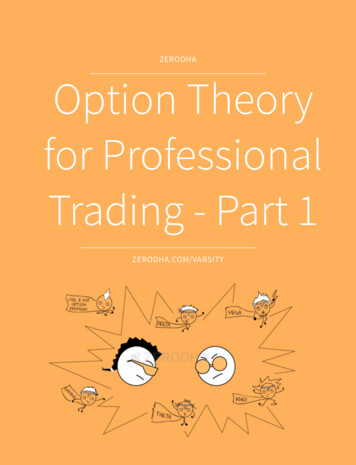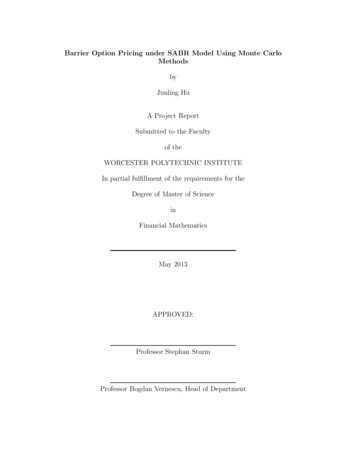
Transcription
Option pricing and spikes in volatility: theoretical andempirical analysis Paola ZerilliBoston CollegeJune 5, 2005AbstractThis paper considers a financial market where the asset prices and the correspondingvolatility are driven by a multidimensional mixture of Wiener shocks and Poissonjumps. While implied volatility is characterized by spikes, the existing models rely onthe restrictive assumption of positive jumps in volatility. To overcome this inadequacy,the present paper introduces normally distributed jumps in the log-variance process.The model proposed is able to mimic empirically observed spikes in volatility and,consequently, improves upon the existing literature as it replicates the main features ofboth the stock return series and the corresponding option prices. After estimating thestock returns via the Efficient Method of Moments, the expression for the valuation ofa plain vanilla European call option is derived, using the no-arbitrage argument.S&P500 option prices are used to assess quantitatively the empirical performanceof the innovative features of the proposed model. The estimates indicate that spikes involatility introduce a significant improvement in option pricing and provide evidencefor stochastic jump risk premia. I am very grateful to Jerome Detemple, Arthur Lewbel, Jushan Bai, David Chapman, Pierluigi Balduzzi,Marcel Rindisbacher, Kit Baum, Rene Garcia and Andrew Lyasoff for their comments and suggestions. Anymistake is mine.1
1IntroductionSince options are derivative securities, their value is strictly tied to the value of the underlying asset. This means that an adequate option pricing model ought to have two maincharacteristics. On one hand, it should replicate as closely as possible the behavior of theunderlying asset price and it should therefore match not only its mean and variance, but alsothe higher moments, such as skewness and kurtosis. On the other hand, it should also beconsistent with the observed option prices, thereby replicating the implied volatility pattern.1Taking the seminal Black and Scholes model as the starting point, many generalizationshave been introduced in order to improve its pricing performance. These include:i) Stochastic Volatility in order to account for negative skewness and high kurtosis in thestock return series;2ii) Stochastic Volatility and jumps in the stock price process so as to improve the pricingof short term options;3iii) Stochastic Volatility and jumps in both the stock price and volatility process in orderto achieve the empirically observed persistence in the impact of jumps.4A major issue, however, remains unexplored since none of the existing models is capableof accounting for spikes in the observed implied volatility. More specifically, in Duffie et al.(2000), volatility is modelled as an affine process that can jump up violently, but that subsequently cannot jump down as observed in the data. Therefore, as Eraker (2003) observesrelying on the assumption of positive jumps in the volatility process, the Duffie et al. (2000)model can explain the abrupt increase in volatility registered on the day of the crash, butnot the subsequent violent fall.The present paper proposes a model for asset pricing that allows for spikes in volatility byconstructing a new, more general log-variance model. The key aspects of the model proposed1While the Black and Scholes model predicts a flat profile for the implied volatility surface, empiricaldata indicate that, especially after the 1987 crash, the implied volatility for equity options strongly dependson the strike price.2See e.g., Cox (1975, 1996), Hull and White (1987), Scott (1987), Wiggins (1987), Stein and Stein (1991),Heston (1993), Naik (1993), Duan (1995), Fouque, Papanicolaou and Sircar (2000), Davydov and Linetsky(2001), Detemple and Tian (2002).3Bates (1996), Scott (1997), Carr et al. (2003)4Duffie, Pan and Singleton (2000)
here are the following:i) stock prices follow a mixture of Brownian motion and multivariate compensated Poisson process;ii) the logarithm of the variance follows an Ornstein-Uhlenbeck process with jumps whosesize is random and whose sign is unrestricted;iii) the stock price can jump both alone and together with volatility.Regarding the choice of a framework for the volatility process, I assume that the logarithmof the variance follows an Ornstein-Uhlenbeck process.5 This choice reflects the ability ofthe exponential function to generate high volatility values in a very limited time. Althoughmany generalizations of the loglinear model have been introduced, there has been so farno exploration of the possibility of Poisson jumps within this framework.6 The closestcontribution in this direction is the model proposed by Duffie et al. (2000) who introducejumps in a Cox, Ingersoll and Ross (CIR) model for volatility (affine process). Compared tothis specification, the model proposed here shows a higher flexibility, since: i) there are noconstraints on the sign of the jumps in the volatility process; ii) the stock price is able to jumpboth alone and together with volatility, unlike in Duffie et al. (2000);7 iii) the exponentialfunction is suitable for modelling moments of market stress, because of its ability to generateextremely high volatility values. All these features enable my model to price a stock and theunderlying derivatives even in the wake of a major financial crisis.In an incomplete market setting, the technique for option pricing adopted in the presentpaper is the Equivalent Martingale Measure approach (as in Jeanblanc-Picque and Pontier(1990), Xue (1991), Shirakawa (1992), Bardhan and Cao (1995), Cox and Ross (1976),Harrison and Kreps (1979)) under which the expected rate of return on any asset is equal5In discrete time, the counterpart of this model can be found in the EGARCH model of Nelson (1991).Alternatively, Scott (1987) assumes that the logarithm of volatility (the square root of the variance process)follows an Ornstein-Uhlenbeck process. Other branches of the literature model volatility as an OrnsteinUhlenbeck process where the underlying state variable is Gaussian (Wiggins (1987), Chesney and Scott(1989), Melino and Turnbull (1990)), as a CIR (Cox , Ingersoll and Ross) process with a reflecting barrierat zero where the underlying state variable is Gamma distributed (Cox , Ingersoll and Ross(1985), Baileyand Stulz (1989), Heston (1993))or as a CEV (constant elasticity of variance) process (Cox (1975), Cox andRoss (1976), Jones (2003)).6Alizdeh et Al. (2002), Chacko and Viceira (1999), Gallant and Tauchen (1999) consider volatility as amultifactor diffusion model.7Duffie et al. (2000) assume that the stock price can jump either by itself or together with the volatilityprocess.1
to the riskless interest rate.8The model proposed in this paper is tested empirically using a two stage approach. Inthe first stage, I estimate the parameters of the structural model for the stock price dynamicsusing the Efficient Method of Moments (EMM) and employing the time series of the S&P500stock returns . This choice reflects the fact that one can observe a part of the state vector (inthis case, the stock return series), but not its corresponding volatility. This necessarily rulesout estimation approaches such as maximum likelihood (MLE) or the generalized methodof moments (GMM). MLE is intractable, while GMM is infeasible.9 The EMM is basedon indirect inference. The main idea is to replace the initial model with a more tractable,approximated one. The latter is denoted the auxiliary model and is a descriptive model witha large number of parameters. Following Gallant and Tauchen (2001), I evaluate the scoresof the auxiliary model using the simulated series of data which derives from the structuralmodel. In this way, I determine the moment conditions for this problem. The proposedlog-variance model is capable of accommodating the linear aspect and the tail behavior ofthe data. In addition, the estimate of the mean of the jumps that affect volatility is negativeand significantly different from zero. This result shows that the assumption of positive jumpsin volatility made by Duffie et al. (2000) is too restrictive.In the second stage, I address a specific question: are spikes in volatility an importantfactor in explaining option price dynamics? I answer this question by investigating whetheroption data show any evidence of jumps in volatility and, more specifically, if my modelcan mimic more adequately and eventually forecast option prices. Holding the first roundof estimates fixed, I price the risk premia embedded in option prices and I estimate the riskneutral parameters. For this second application, I use the cross section data on the S&P500call options. I find that employing a log-variance model with spikes dramatically improvesthe pricing performance. In addition, I find evidence for stochastic risk premia.The outline of this paper is as follows. In section 2, I clarify the core of the entire debate.Section 3 contains the setup of the model. The relevance of the risk premia and of the binding8Another approach often used by many authors (e.g.: Bates (1998), Naik and Lee (1990), Aase (1993),Dieckmann (2002)) is based on a general equilibrium argument and explicitly links the risk premia to thepreference parameters of the representative agent when the markets are incomplete.9The moment restrictions lack an analytical representation in terms of the observables and unobservables2
no arbitrage condition is addressed in Section 4 which also lays the Equivalent MartingaleMeasure approach. In Section 5, I explain the estimation methods adopted in the paper.Finally, Section 6 shows the empirical results and corresponding diagnostics and Section 7concludes.2The origins of the debateWhen pricing an option, the first task one faces is to value the underlying assets (such asstocks, futures or currencies) on which the option depends. In the past, the empirically observed absence of significant autocorrelations in the stock returns led to modelling them asindependent random variables, or more precisely, as random walks in discrete time. By applying the Invariance Principle (Functional Central Limit Theorem), Brownian motion canbe seen as the continuous time counterpart of the random walk process. In 1900, Bachelierproposed the following very simple model for stock pricing:St S0 σWtwhere Wt is a Brownian motion process.In 1973, a similar setting was adopted by Black and Scholes in their seminal paper foroption pricing:St S0 exp (µt σWt )Lately, this approach has been criticized for its failure to capture important featuresof both stock and option price data because it relies on the restrictive assumption of independence of returns. Even though it has been observed that the stock returns are notautocorrelated, several tests have shown that non linear functions of returns are indeed autocorrelated (see Figure 1). These tests are based upon the analysis of several autocorrelationfunctions such as, for example:i) the autocorrelation function of various powers of returns:C1τ corr ( r(t, τ ) ε , r(t τ , τ ) ε )3
ii) the autocorrelation of absolute power of returns:C2τ corr (ln r(t, τ ) , ln r(t τ , τ ) )iii) the correlation of returns with subsequent squared returns:¡ C3τ corr r(t τ , τ ) 2 , r(t, τ )for some given time lag τ .This stylized fact, often referred to as volatility clustering, represents a clear violation ofthe independence assumption and means that large price movements are typically followedby other large movements.Furthermore, large downward movements are usually observed more often than theirupward counterparts. Translated in statistical terms, this means that the stock returnsshow negative skewness. Since the Black and Scholes model cannot replicate heavy tails inthe distribution of returns (high finite kurtosis) and instead predicts zero skewness, it failsto capture these important empirical features of the stock returns.As the model’s ultimate goal is to price options, another way to test its empirical performance is to check how precisely it can replicate actual option prices. Given the assumptionsof the Black and Scholes model, if it correctly resembled the option price behavior, the sameimplied volatility should characterize all otherwise identical options despite the presence ofdifferent strike prices. Figure 2, which represents the market implied volatility vs. the optionmoneyness, shows clearly that, for empirical implied volatilities, this is not the case.In order to eliminate these biases, many generalizations of the Black and Scholes modelhave been introduced. The jumps in the return process allowed for by Merton (1976) improved the tail behavior (skewness and kurtosis). However, unlike the corresponding empirical time series characterized by volatility clustering, the resulting process for stock returnsstill retains the property of independent increments. Models with stochastic volatility without jumps, are capable of replicating important features such as the tail behavior of thestock returns, volatility clustering and leverage effect, and they reproduce realistic impliedvolatilities for long maturities. At the same time though, they fail to yield a realistic implied4
volatility pattern for short maturities.10 The latter feature can instead be easily capturedby introducing jumps that reproduce realistic implied volatility smiles at short maturities.11The evidence from the existing literature seems thus to suggest that the way forwardlies in combining both stochastic volatility and jumps in a model for stock returns.12 Oneof the most recent contributions is the model by Duffie et al. (2000) which features jumpsin both volatility and stock return processes. This model can explain violent and persistentmarket movements with upward movements in volatility, though it cannot reproduce volatility spikes. These large market movements, far from being simple outliers, are an importantcharacteristic of the stock return time series.The goal of the present paper is to propose a new model for stock pricing that can replicatespikes in volatility. This model shall be estimated by the Efficient Method of Moment usingstock return series. Finally, after deriving the corresponding call option prices by MonteCarlo simulation, the risk neutral parameters and the risk premia shall be evaluated byminimizing the squared deviations from the market implied volatility.3Security Market ModelThe σ field Ft represents the information that investors have at each point in time t [0, 1]with Fs Ft if s t. Suppose that (Ω, P, F) is the probability space for this model. Morespecifically, P is the probability measure which represents the investors’ beliefs, Ω is the setof states of the world and F F1 is the set of events that can be seen at the trading horizon.The filtration F {Ft ; t [0, 1]} is assumed to be right continuous and P -complete. In thiseconomy there are N stocks. The price of the stock portfolio St , at time t is assumed tofollow a mixture of Brownian motion and multivariate compensated Poisson process. Morespecifically, the stock price process is right continuous (securities are traded ex-dividend)and left limited13 .10See, for example, Cox (1975, 1996), Hull and White (1987), Scott (1987), Wiggins (1987), Stein andStein (1991), Heston (1993), Naik (1993), Duan (1995), Fouque, Papanicolaou and Sircar (2000), Davydovand Linetsky (2001), Detemple and Tian (2002).11See, for example, Cox and Ross (1976) and Merton (1976).12Bates (1996), Scott (1997), Carr et al. (2003)13One can assume, without loss of generality, that the left limit exists and is finiteSnt limu t SnuConsequently, the jump of the stock price at time t will be5
Besides the bond Bt e rt , there is a portfolio of risky assets and a stochastic volatilitycomponent qp ·2d ln St µdt Vt β 12 dW2t 1 β 12 dW1tZZq2 1 ψ 33ζ 1 (Γ) P1 (dΓ, dt) ψ 33R\{0}(1)ζ 2 (Γ) P2 (dΓ, dt)R\{0}where the stochastic part of the corresponding volatility follows the lawVt exp(Ut )¡ dUt µU α22 Ut dt β 20 dW2t Zζ 3 (Γ) P2 (dΓ, dt)(2)R\{0}where ζ 1 (Γ) N(ψ 11 , ψ 212 ) , ζ 2 (Γ) N(ψ 13 , ψ 223 ) and ζ 3 (Γ) N(ψ 21 , ψ 222 ).Rζ (Γ) Pj (dΓ, dt) µζ i λj dt for i 1, 2, 3 and j 1, 2 are the compensated PoissonR\{0} iRrandom measures. More specifically, R\{0} ζ i (Γ) Pj (dΓ, dt) counts the number of jumps withrandom size ζ i (Γ) in the set R\ {0} during the small time interval dt. Pj (dΓ, dt) 1 justwhenever the jump event of size ζ i (Γ) happens, Pj (dΓ, dt) 0 in all the other cases.The intuition behind these two equations is very simple. The stock price St is allowed tovary not only over time, but also in response to two kinds of shocks:i) diffusive shocks such as W1t , W2t which affect the stock price gradually and by smallamounts. Any diffusive shock affecting the volatility process impacts the stock price processthrough the “weak leverage effect” β 12 .ii) Poisson driven shocks represented by the random measures P1 and P2 which accountfor abrupt and huge changes in the stock price. P1 represents the number of jumps, withstochastic size ζ 1 , experienced by the stock return over the time interval (0, t]. P2 plays thesame role as P1 , but it regulates the time varying impact exerted on the stock price by anyshock to the corresponding volatility. In this case, the jump size is ζ 2 . We are thus in theposition to replicate the abnormal market movements taking place when volatility is affected Snt Snt Snt 6
by huge shocks which are transmitted to the stock price through the “strong leverage effect”ψ 33 .4Risk neutral pricingFollowing the Black and Scholes (1973) and Merton (1973) approach in order to price derivative securities, the only assumption one needs to make about agents’ preferences is nonsatiation (agents prefer more to less). Therefore, the price of a derivative security must bethe same regardless of the agents’ risk tolerance. This means that, in order to rule out anyarbitrage opportunity, a risk averse economy must price an option exactly in the same wayas a risk neutral economy. In particular, in a risk neutral setting, the expected rate of returnof any asset must be equal to the riskless interest rate r (Cox and Ross (1976)):EtQ· dSt δdt r dtSt· Q dStEt (r δ) dtSt rdtwhere EtQ [.] is the expectation at time t taken with respect to the probability measureQ adjusted to be consistent with risk neutrality, r r δ and δ is the constant dividendrate. In more detail, the main portfolio is transformed as follows: ·1eed ln St r Vt γ 1 λ1 γ 2 λ2 dt2 qp ·2 ff Vt β 12 dW2t 1 β 12 dW1tZZq2ee 1 ψ 33ζ 1 (Γ) P1 (dΓ, dt) ψ 33R\{0}d ln Vt R\{0}(3)eζ 2 (Γ) Pe2 (dΓ, dt)³ µU α22 ln Vt β 20 ϑ2 (λ2 φ3 ) γ 3 eγ 3 λ2 dtZef2t ζ 3 P2 (dΓ, dt) β 20 dWR\{0}7
f1t dW1t ϑ1 (Vt )dtdWZR\{0} ZR\{0}ZR\{0} ZR\{0}ZR\{0} ZR\{0}f2t dW2t ϑ2 (Vt )dtdW³ e1 dte1 λγe1 Pe1 (dΓ, dt) γ(4)((γ 1 P1 (dΓ, dt) γ 1 λ1 dt) γ 1 φ1 (Γ)dt) ³e2 dte2 λγe2 Pe2 (dΓ, dt) γ(5)((γ 2 P2 (dΓ, dt) γ 2 λ2 dt) γ 2 φ2 (Γ)dt) ³e2 dte3 λγe3 Pe2 (dΓ, dt) γ(6)((γ 3 P2 (dΓ, dt) γ 3 λ2 dt) γ 3 φ3 (Γ)dt)e 11 , ψe2 ) , ee 13 , ψe 2 ) and ee 21 , ψe 2 ) , Pe1 P oisson(λe1 )ζ 2 N(ψζ 3 N(ψwhere eζ 1 N(ψ122322e2 ) and where ϑ1 (Vt ) and ϑ2 (Vt ) are the risk premia that compensate theand Pe2 P oisson(λinvestor for bearing the diffusive risks W1t and W2t . φ1 (Γt ) φ2 (Γt ) and φ3 (Γt ) are the jumprisk premia that are meant to compensate the investor for facing the risk of abrupt changesof the stock price and are a function of some general stochastic process Γ. We elaborateon these terms below. The original sources of randomness (Brownian and Poisson drivenshocks) are now transformed in order to embed proper risk premia as proper adjustment forrisk neutrality.f1t and Wf2t are Brownian motions, while Pe1tQ is the probability measure under which Wand Pe2t are the Poisson processes respectively. In a more formal manner, Harrison and Kreps(1979) show that, under Q, the discounted stock price is a martingale:· StQ ST .EtBTBt8
The relation between the initial probability measure P and the risk adjusted counterpart(Equivalent Martingale Measure) is regulated by the Radon-Nikodyn derivativeηt EP·whereZ dQ ztdP tηt 1 η u (ϑ1 (Vu )dW1u ϑ2 (Vu )dW2u )0Z tZ (Φ1 (Γ) P1 (dΓ, du) φ1 (Γ) du) 0R\{0}0R\{0}(Φ2 (Γ) P2 (dΓ, du) φ2 (Γ) du)0R\{0}(Φ3 (Γ) P2 (dΓ, du) φ3 (Γ) du)Z tZZ tZ(7)This change of probability measure is accomplished by the Girsanov theorem. As pointedout by Harrison and Kreps (1979), this change in the probability measure consists of aredistribution of probability mass such that the expected rate of return of every asset becomesequal to the riskless rate of interest rt and the set of events which initially had positiveprobability remains unchanged14 . The main point of this probability transformation is toensure that all arbitrage opportunities are ruled out. This goal is reached by assuming that η tembeds as many risk premia as the number of sources of risk present in this economy.15 φ1 (Γ), φ2 (Γ) and φ3 (Γ) simultaneously compensate the investor for the jump size uncertainty andthe jump timing uncertainty. In order to ensure that no arbitrage opportunities are possible,the whole set of risk premia must respect the following condition:14Following Harrison and Kreps (1979), the equivalent martingale measure is a probability measure Q on(Ω, z) such thati) P and Q are equivalent. This means that the null sets of P and Q coincide or, in other terms, thatP (B) 0 if and only if Q (B) 0 for any B z.¡ 2 ii) The Radon-Nikodym derivative η dQ .dP is such that E ηSteiii) The discounted stock price St Bt is a martingale over the fields {zt } with respect to Q or, in otherh i terms, E Q Ses zt Set for any s t.15The explicit expression for η t is derived in Appendix F.9
r r δ 1 µ Vt γ 1 (λ1 φ1 ) γ 2 (λ2 φ2 )2¶qp µ2 Vt β 12 ϑ2 1 β 12 ϑ1(8)where Vt f (ϑ2 (Vt ), φ3 (Γ)) and δ is the dividend rate.Equation (1.8) is simply the translation in mathematical terms of the principle that theexpected rate of return of the stock under consideration is equal to the riskless interest rater minus the constant dividend rate δ.Following Cox and Ross (1976), after neutralizing any source of risk by compensating theinvestor with the appropriate risk premia, one can price any derivative security in the waya risk neutral economy would do. Therefore, the option price is only the expected value ofthe total payoffs discounted at the riskless rate r minus the constant dividend rate δ:Ct e r(T t) EtQ [Max {ST (ξ 1 , ξ 2 ) K, 0}]where· 1eeST S0 expr Vu γ 1 λ1 γ 2 λ2 du20 Z Tp ·q2 ff Vu β 12 dW2u 1 β 12 dW1u0Z TZZq2eeζ 1 (Γ) P1 (dΓ, du) ψ 33 1 ψ 33½ZT00R\{0}ξ1 TZR\{0}¾eζ 2 (Γ) Pe2 (dΓ, du)(α10 , β 12 , ψ 33 , ψ 11 , ψ 12 , ψ 13 , ψ 23 , ψ 13 ,α20 , α22 , β 20 , ψ 21 , ψ 22 , λ1 , λ2 )is the vector of the parameters of the stock price and volatility processes and ³e 11 , ψe 12 , ψe 13 , ψe 23 , ψe 13 , ψe 21 , ψe 22 , λe1 , λe2ξ 2 ϑ2 (Vt ), ψis the vector of the risk adjusted parameters.10
The entire analysis is carried out in an incomplete market setting where the sources ofrandomness outnumber the traded assets. The lack of an expression describing all the riskpremia in this economy and the non-uniqueness of the equivalent martingale measure areovercome by means of the empirical estimation of those premia.5Estimation MethodIn principle, this model could be estimated using maximum likelihood estimation (MLE) andSemi Non Parametric (SNP) methods. Since volatility is a latent variable, MLE would betoo demanding and intensive from the computational point of view. Indeed, volatility oughtto be integrated out of the likelihood function and the dimension of this integral would be aslarge as the number of observations in the time series. For similar reasons, SNP proceduresare also not easily implemented. Monte Carlo simulation methods allow us to evaluate theGMM criterion when, as in this case, a closed form specification of the moment conditions isnot available. These methods show a greater flexibility as they can be easily used to estimatea wide range of different models and, at the same time, they provide useful diagnostics aboutthe model specification.Other possible approaches which involve the use of semi-nonparametric procedures arevery problematic to use when volatility is unobservable.16A possible alternative to this approach would involve the use of both series of data, thestock return series and the cross section of option prices at the same time. However, whilethis technique appears more intuitive for its ability to supply directly the estimates of therisk premia, it is vulnerable to the critique that the Efficient Method of Moments (EMM)estimates based on a multidimensional auxiliary model (see Duffee and Stanton 2001) sufferfrom poor finite sample properties. Moreover, the use of return and option data at the sametime is computationally so intensive that its implementation typically involves the use of veryshort data sets. An example can be found in Chernov and Ghysels (2000) who estimate theHeston model by EMM using stock and option data at the same time. The multidimensionalapproach is also employed by Pan (2001) who estimates a square root model with jumps byGMM, by Eraker who evaluates the Duffie et al. model by the Markov Chain Monte Carlo16See, for example, Hansen (1995), Ait-Sahalia (1996), Jiang and Knight (1997) and Johannes (1999).11
(MCMC) technique and Jones (2000) who chooses a CEV (Constant Elasticity of Variance)model. Alternatively, the unidimensional approach (where only the stock return series isused) is chosen by Andersen et al. (2002) and Chernov, Gallant, Ghysels and Tauchen(2003) who use the EMM to estimate the parameters of many possible models for the stockreturn process. Eraker et al. (2003), instead, estimate the Duffie et al. model by the MCMCtechnique.A two stage method will be adopted in this paper. In the first stage, the parametersof the structural model for stock pricing will be estimated using the Efficient Method ofMoments. The choice of this method is due to the complex form of the structural modelwhich shall be replaced by an approximated counterpart (auxiliary model) which is easierto handle. This auxiliary model has mainly a descriptive function and does not have aninterpretation in terms of the structural model. It usually contains a very large number ofparameters for purposes of calibration. As the number of these parameters increases, theauxiliary model gives a good approximation for the distribution of the data with the potentialto reach asymptotic efficiency. In the second stage, holding the estimates of the structuralparameters fixed, this paper estimates the risk premia embedded in the call option prices soas to minimize the implied volatility mean squared residuals.5.1Stage one: estimating the stock return and volatility parameters by EMMIn the initial stage, the parameters of the stock price and volatility processes will be estimatedvia the Efficient Method of Moments. Specifically, the vector of parameters to be estimatedat this point is (see equations [1] and [2]):ξ1 (α10 , β 12 , ψ 33 , ψ 11 , ψ 12 , ψ 13 , ψ 23 , ψ 13 ,α20 , α22 , β 20 , ψ 21 , ψ 22 , λ1 , λ2 )Since the stochastic volatility is unknown, this latent variable must be integrated out inthe computation of the loglikelihood. In this case, the dimension of the integral is the sameas the sample size. Therefore, the direct evaluation of the likelihood function is either computationally intensive or infeasible. This is the main reason why several authors (see Gallantand Tauchen (1996), Pan (2002), Chernov, Gallant, Ghysels and Tauchen (1999), Ander12
sen et al., (2000)) have employed EMM, thus avoiding direct estimation of the likelihoodfunction.The key aspect of this method is the efficiency of the standard GMM (Generalized Methodof Moments). This efficiency is associated with a careful choice of the moment conditionsbased upon a detailed analysis of the main features of the observed data. As a result, theEMM is a methodology for the estimation and analysis of non linear systems of partiallyobservable variables. This method is based on the simulation of the state vector.The initial step consists in choosing an appropriate transition density called auxiliarymodel, which is a close approximation of the data generating process. The parameters ofthis density are estimated by QMLE (Quasi Maximum Likelihood Estimation). The scoreof this model represents the score generator for EMM.5.1.1Choice of the auxiliary modelThe EMM is based on indirect inference. The main idea is to replace the initial model withan approximated one that is more tractable. This model, denoted the auxiliary model, isa descriptive model with a large number of parameters. In particular, its parameters donot have any structural interpretation, but are only used for calibration purposes. As theirnumber increases, asymptotic efficiency is reached.Following Gallant and Tauchen (2001), the auxiliary model is derived by using the socalled SNP (Semi-Non-Parametric) approach. This method is considered to lie halfwaybetween the parametric and non parametric inference procedures, since classical parametricestimation is applied to models with truncated series expansions. The main purpose ofthis section is to find an auxiliary model that closely approximates the density of the data.The corresponding density function is then approximated using a Hermite expansion, whoseleading term is a standard Gaussian density. The higher order terms of this expansion willaccommodate any deviation from Gaussianity as, for example, high kurtosis and negativeskewness.Letyt 100[ln(S1t ) ln(S1t 1 )]be the daily stock return for our estimation problem and {y1 , y2 , ., yn } t
a plain vanilla European call option is derived, using the no-arbitrage argument. S&P500 option prices are used to assess quantitatively the empirical performance of the innovative features of the proposed model. The estimates indicate that spikes in volatility introduce a significant improvement in option pricing and provide evidence

